Developer Insights #17 - Engine Archetypes
Engines: How to Avoid Shipping a Rocket Scientist
We’ve mentioned approachability as a core pillar of our KSP2 design, and I’m here today to talk about one of the less-obvious ways we are focusing on helping players reach the stars.
An area we’ve noticed players struggling with in testing is making sense of the dizzying array of engines you’re presented with in the VAB. KSP1 had 35 engines for you to choose from (more if the Making History DLC is installed), spread across Liquid Fuel/Oxidizer, Liquid Fuel, Monopropellant, Xenon and Solid fuel types. This leads to a good deal of player confusion when starting out – what engine should I use? What engine is best for what I want to do? Why isn’t this rocket lifting off the pad even though I put 20 Terriers on it? There’s a lot of trial-and-error gameplay before you learn the hard-won lessons about specific impulse, thrust to weight ratio, and fuel density that can rocket you to success in KSP. Hah.
It unfortunately gets a bit worse. When you're looking for an engine, all of your important details are buried deep. You're searching for specific impulse, thrust, mass, heat production, and how the engine performs in multiple situations (sea level, orbit, other planets). It's a lot of work when you're learning!
When we look at our plans for KSP2, we’re only making this problem worse. We’re adding more engines, more fuel types and more engine sizes. Ouch. Clearly, we need to find good ways to teach new and returning players how to select an engine and teach players at the very least which engines are better at which missions they want to accomplish. I’m going to go into some detail on how we’re going to work towards addressing this, focusing in on the most common type of engines in KSP – the venerable liquid fuel engine category, which boasts such illustrious names as the Mainsail, Rhino and… Ant.
Liquid Fuel -> Methane
Before we get into this, a bit of terminology. Let’s start with talking about… methane and methane accessories. KSP1 gave us an abstracted resource to run our most common workhorse engines: the well-regarded Liquid Fuel . For KSP2, we’ve decided to take this resource and… name it. It’s methane. For their space program, Kerbals have passed over the brutish kerosene, toxic hypergolics and seductive lure of liquid hydrogen to settle on this nice middle ground fuel. It’s a good choice – a number of commercial companies are currently moving engines using methane and oxygen propellants to operational readiness.
When we talk about engines you might recall from KSP1 that sported the Liquid Fuel/Oxidizer moniker, we’re always talking about methalox engines. Yes, this nomenclature change applies to jet engines as well for simplicity, so jet engines are now methane engines.
Engine Archetypes
So, looking in detail at the methalox engines we have inherited from KSP1, we can see that we’ve got an interesting challenge on our hands. More than half of those 35 engines are methalox, and they’re practically the first engines a player gets introduced to. If we’ve done our job right, they’ll continue to be useful engines in some niche even after you have access to objectively more power engines, so they’ll stick around for a while. So, how to sort and help players determine how best to use them? I’ll present the concept of Engine Archetypes.
Rocketry fans will be familiar with three high-level types of liquid fuel engines. Firstly we have the high-thrust, high power engine which we can call the booster engine. These engines are great for getting a ship out of the atmosphere and pushing really heavy payloads, but don’t [SG16] have the efficiency to make them great deep space engines. Examples of this could be the Saturn V’s F-1 engines, or the Falcon 9’s Merlin engines.
Secondly, we have the sustainer type engine. This is typically a more efficient engine that burns for a longer duration, but doesn’t really have the oomph needed to throw heavy payloads into orbit without a little help. This type of engine is often paired with extra boosters of some type to get a kick up into orbit. Good examples of this include the Space Shuttle’s RS-25 engines and the Ariane series of rockets’ Vulcain engines.
Thirdly we have pure vacuum, orbit-only engines, best for operating in the cold depths of space and really, really efficient, but it will be lucky to push an overstuffed Kerbal though even thin atmospheres. A shining example here is the Aerojet RL-10 engine, which has existed for so long (early versions flew in the early 1960s, and the current version is used on the SLS rocket’s Interim Cryogenic Propulsion Stage) that it is basically the kitchen appliance of rocketry.
We can map these engine archetypes to KSP engines fairly well – see the following table.
Archetype KSP Examples
Booster Reliant, Mainsail, Mammoth
Sustainer Swivel, Skipper, Rhino
Vacuum Ant, Terrier, Poodle
This provides a good starting point for laying out KSP2’s methalox engine lineup.
Vacuum Engines – an aside
We’re always looking for opportunities to improve teaching about real rocketry concepts. One of the places KSP1 hasn’t quite lined up with the literature is the nature of the vacuum engines it uses. In reality, the shape and size of the nozzle attached to a rocket engine makes a big difference in terms of its performance at different atmospheric pressures. A good way of looking at this is to compare something called expansion ratio – which is a measure of the difference between the area of the engine’
s throat and its area of the nozzle exit. In vacuum, the ideal expansion ratio is extremely large – a good vacuum engine has a very narrow throat compared to its exit. To make a given engine work better in vacuum, we use a really big nozzle (though there’s obviously a lot more to it that just making your booster engine’s nozzle bigger).
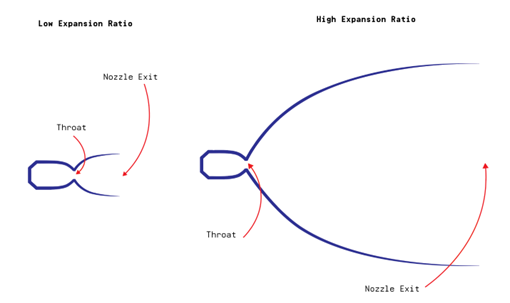
Simplified rocket engines with small and high nozzle expansion ratios.
Of course, reality sets in here because you can’t just add moar expansion ratio (a multi-kilometer wide nozzle might be a bit heavy) .Rocket scientists have tested novel concepts like the inflatable nozzle (look this one up), the hinged nozzle, and other creative ways of compressing nozzles so they become really big in orbit but can be launched with a smaller footprint. A working example of that is the RL-10B-2 engine that uses an extending lower nozzle cone that deploys once the rocket’s upper stage separates. You’ll see something like that in KSP2 with our NERV-US engine.
Unfortunately, KSP1’s vacuum engines are actually smaller than their atmospheric counterparts, which causes no end of consternation among the more technically minded of KSP players. This is a bit of dichotomy, because we all love using the Terrier and Poodle as lander engines due to their small footprint and suitability for landing legs. For KSP2, we will we be looking at moving towards a model that keeps these heritage KSP1 engines around as a subclass of engines that we’ll define as the Orbital class. These will maintain some level of excellence in space, get a bump to their atmospheric stats and leave the door wide open to the long, efficient Deep Space class of engine that lines up more with idealized vacuum engines – a new set we’ll be introducing through Early Access.
KSP2 Methalox Engine Archetypes
So, given all the above we have defined four engine archetypes: Booster, Sustainer, Orbital, and Deep Space.
With these archetypes in mind, we can design for them and use them to teach players. Players who know how to use Thrust and ISP to find the engines they want still have that information. More novice players can build to that point by first learning archetypes.
How do we teach archetypes? Well, here’s what we’re working on:
Terminology: We have aligned ingame terminology, like subtitles and descriptions, to specifically work on teaching player that any given engine belongs to specific archetypes. At Early Access you’ll for example see the Mainsail comes with a tagline of ‘Methalox Booster Engine’ that helps players situate it in the hierarchy of engines.
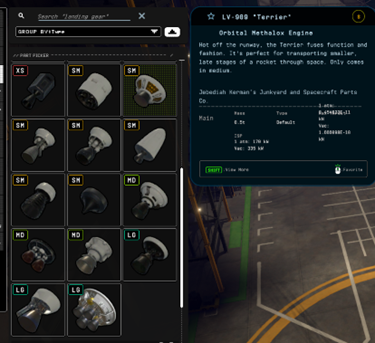
Archetype subtitle for the Terrier
Visuals: We have created specific design languages for each engine type, so picking up an engine and looking at it will be a good way to think about how it performs. Building these languages into our engine models is going to be an ongoing process through Early Access.
Balance and Tuning: We have mapped broad bands of engine characteristics to types, and then aligned many engines to better tell their stories. There are always strange engines, but they get to be strange because standard engines exist (like the Dart, that weird little aerospike guy).
Visual Language
Having good visual language for concepts is one of my passions. We want KSP’s rocket engines to be similar to, but not be real life engines. Reality is full of cool engines, and some of our engines hew very close to existing or conceptual designs. It's tempting to do that all the time, but the closer we lean to reality, the more the engines must skew to reality in all regards. I call this the "Why can't I build a space shuttle with three Vectors" problem.
In addition, we’re unlikely to have anything close to the great variety of fuels and tanks that reality has, so being very high fidelity with designs for engines creates disconnects for a detail-oriented realism players (this terrain is great for modders). Instead, when we’re looking at our archetype language for KSP, we will try to be a bit more general and inspired by real engines, rather than creating exact copies.
I’ve put together some sketches of these four archetypes to guide our artistic design going forward. The goal is for each of them to have a distinct visual look that is preserved through all size classes, and is versatile enough that, for example, a Mainsail doesn’t just look like a smaller Mammoth. We can pick and choose from a number of reality-alike design elements to create cool, Kerbal-native engines.
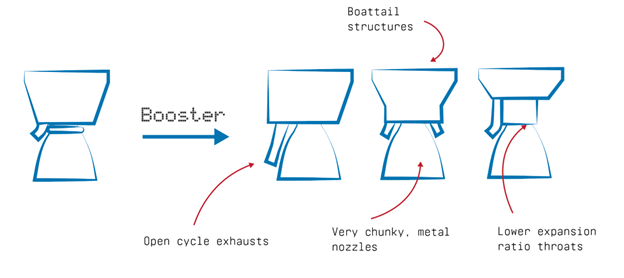
Booster engine features and possible design variations

Sustainer engine features and possible design variations
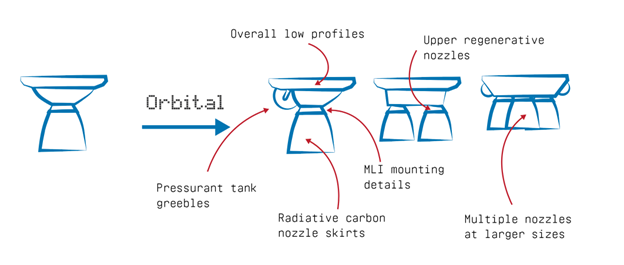
Orbital engine features and possible design variations
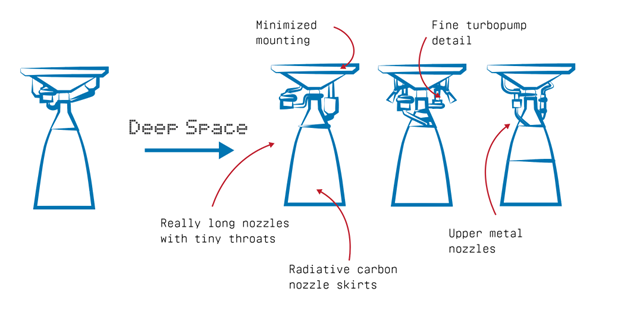
Deep Space engine features and possible design variations
The first place you’ll see this visual language in Early Access is the 3.75m engine lineup featuring the Labradoodle, Mammoth-II, and Rhino.
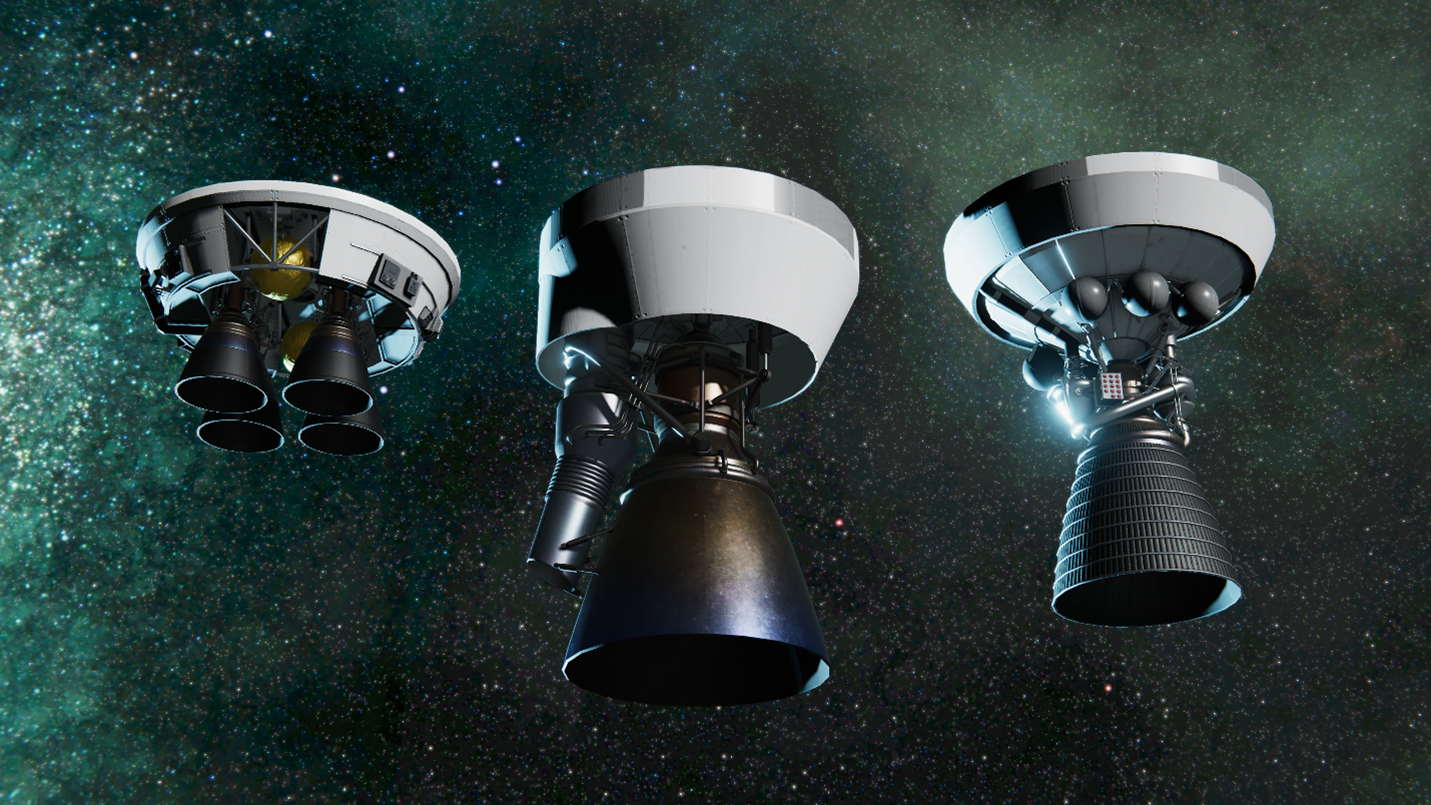
Applied design! From left to right, the Labradoodle, Mammoth-II and Rhino engines sporting, respectively, Orbital, Booster and Sustainer visual queues, courtesy of artists Jonathan Cooper and Pablo Ollervides.
Balance and Tuning
As we get to the end of this article, I wanted to touch on balance and tuning. Our guiding principles in tuning engines can be summed up with 3 points:
Don't deviate from KSP1 for the sake of it. A methalox rocket in KSP2 should perform similarly to a similar looking Liquid Fuel/Oxidizer rocket from KSP1
Engines of an archetype have similar characteristics.
Engines within a fuel type exist in a similar band of power, so newer or larger engines should not make older engines obsolete.
These rules still give us a lot of room for play while letting us increase approachability. Some engines, like the Vector, needed a hard look under these guidelines.
We’re basically trying to follow this chart, which I find a useful way of looking at the overall capabilities of engines. If an engine is a Methalox Sustainer, it should fall in the blue region, as an example – and we are really trying to keep things out of the Useless and Way Too Useful regions 😉. The Way Too Useful region is a story for later in Early Access with more exotic engines , which have their own, unique challenges for building and flying.
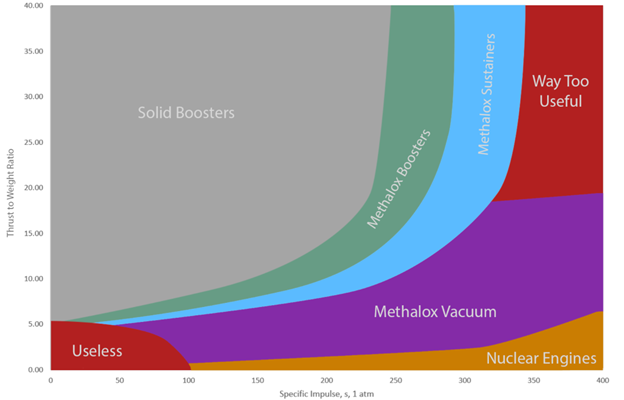
Taken together, this means that outside of some specific areas, you won’t see massive statistical changes to most engines in KSP2 from KSP1, despite the naming change from Liquid Fuel and Oxidizer to Methalox. Places to watch out for are:
KSP2’s 3.75m engines have had some overhauls to account for the addition of an Orbital engine in this size class (say hello to the Labradoodle, as named by Scott Manley!)
KSP2’s Orbital engines have better atmospheric performance than their KSP1 counterparts.
The relationship between the Mammoth (now Mammoth-II) and the Vector has been adjusted for KSP2, as they no longer need to match visually.
Putting it all Together
I can sum everything up using a table. Tables are almost my favorite things, narrowly being edged out by graphs.
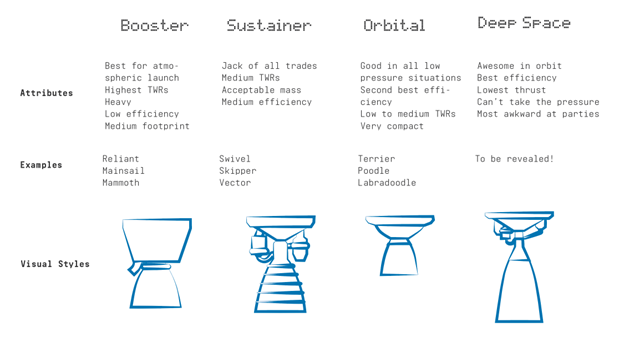
Other Fuels
“But Chris!”, you say, “I thought KSP2 was about MORE than just Methalox?”. That’s absolutely true, and we’ll be looking to follow the same general rules when creating archetypes through other fuel types as we reveal things through Early Access.
